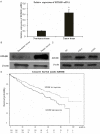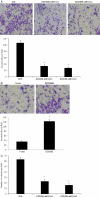KDM6B induces epithelial-mesenchymal transition and enhances clear cell renal cell carcinoma metastasis through the activation of SLUG
- PMID: 26261509
- PMCID: PMC4525843
KDM6B induces epithelial-mesenchymal transition and enhances clear cell renal cell carcinoma metastasis through the activation of SLUG
Abstract
Clear cell renal cell carcinoma (ccRCC) is one of the most common kidney cancers; epithelial-mesenchymal transition (EMT) is associated with carcinoma invasion and metastasis. There have been several studies about the molecular regulation of EMT, but the relationship between histone demethylase and EMT is little known. Here, we reported KDM6B has high expression level in ccRCC and is positively correlated with poor ccRCC prognosis. KDM6B, also known as JMJD3, is a histone demethylase, can remove repressive histone H3K27me3 marks from chromatin, thereby activating gene expression. We found that the knockdown of KDM6B could inhibit ccRCC tumorigenesis in vitro; furthermore, KDM6B could induce EMT in ccRCC cells by activating the expression of master transcription factor SLUG. ChIP assays revealed that KDM6B stimulated SLUG expression by demethylate histone H3K27me3. The knockdown of KDM6B strongly inhibited ccRCC cell invasion in vitro, while the overexpression of KDM6B shown the opposite trend. Meanwhile, our analysis of the ccRCC tissue found that KDM6B expression was significantly corresponded with lymph node metastasis. Together, our data provide a novel epigenetic mechanism regulating tumor cell invasion and EMT, and provide a biomolecule for ccRCC diagnosis and prognosis.
Keywords: EMT; KDM6B; SLUG; ccRCC.
Figures





References
-
- Rini BI, Campbell SC, Escudier B. Renal cell carcinoma. Lancet. 2009;373:1119–1132. - PubMed
-
- Jemal A, Siegel R, Ward E, Hao Y, Xu J, Thun MJ. Cancer statistics, 2009. CA Cancer J Clin. 2009;59:225–249. - PubMed
-
- Cheville JC, Lohse CM, Zincke H, Weaver AL, Blute ML. Comparisons of outcome and prognostic features among histologic subtypes of renal cell carcinoma. Am J Surg Pathol. 2003;27:612–624. - PubMed
-
- Jenuwein T, Allis CD. Translating the histone code. Science. 2001;293:1074–1080. - PubMed
-
- Kouzarides T. Chromatin modifications and their function. Cell. 2007;128:693–705. - PubMed
Publication types
MeSH terms
Substances
LinkOut - more resources
Full Text Sources
Other Literature Sources
Medical
Research Materials
